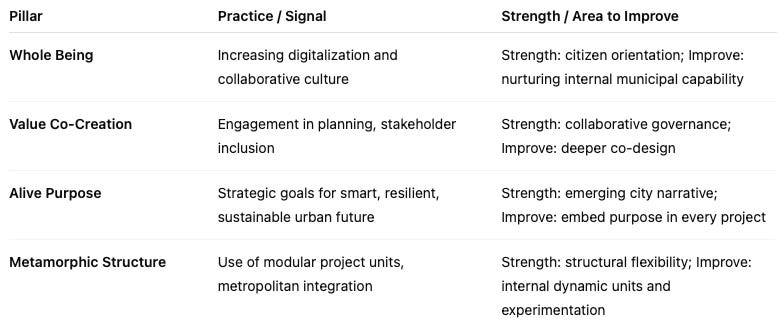Oradea Municipality - Case Study
Transforming a City Government into a Living, Adaptive Urban Ecosystem
Context and Overview
Oradea is a mid-sized Romanian city (population ~180,000) and capital of Bihor County. Over the past decade, it has become noted for bold municipal reforms, infrastructure modernisation, public transport expansion, and strong EU fund absorption.
From about 2008 onward, under Mayor Ilie Bolojan, Oradea embarked on deep changes: modernisation of streets, historic center rehabilitation, administrative efficiency, attracting investments. Although Bolojan stepped down in 2020, many initiatives continue under new municipal actors.
Strategic documents like the Integrated Urban Development Strategy (SIDU), Sustainable Urban Mobility Plan (SUMP), and Sustainable Energy & Climate Action Plan (SEAP) show a long-term orientation and multi-stakeholder framing.
There is also academic and practitioner interest in Oradea’s model of collaborative governance — involving stakeholders in decision making, e-governance, smart orientation, and transparency.
Thus, Oradea offers a rich canvas to explore how a city government aspires toward “aliveness” — a living public system.
1. Whole Being — Public Servants as System Stewards
For Oradea to embody Whole Being in its municipal culture, the city would need to foster a sense of vocation, psychological safety, collective ownership, and identity among its civil servants.
Current signals & possible practices:
The shift toward e-governance and online service delivery suggests a push for more agile, responsive public work. (A study of Romanian city halls finds increasing resilience and online adoption from 2014 to 2023)
Transparency and collaborative governance practices, as studied, imply cultural change toward inclusion of external voices.
The municipal administration’s strategy for inclusive stakeholder engagement in urban planning (via SIDU and SUMP) implies recognition that people (citizens, institutions) matter in planning.
Areas for development:
Strengthening internal practices of reflection, shared learning, and employee agency
Building mechanisms for frontline staff to propose and pilot innovations
Cultivating psychological safety across departments under the weight of regulatory constraints
2. Value Co-Creation — Governance With Citizens & Ecosystem Actors
Oradea is already working toward co-creative urban management.
Examples & signals:
Studies of Oradea highlight its collaborative governance model in smart city initiatives, where the municipality involves stakeholders (citizens, businesses, universities) in planning and decision-making.
The city has accessed substantial EU funds for urban and transport infrastructure projects, often via programs requiring co-financing and stakeholder alignment.
The strategic planning documents (SIDU, SUMP) are designed to incorporate multiple sectors and voices across metropolitan area, encouraging integrative planning.
Projects on urban resilience (e.g. heat-wave adaptation) point to engagement in nature-based solutions with community involvement.
This indicates Oradea is evolving from municipality as regulator to municipality as convener, co-creator, coordinator in a broader urban ecosystem.
3. Alive Purpose — City as a Living, Innovative Hub
A city’s superior purpose must transcend service delivery. For Oradea, we can detect the seeds of a purpose oriented to resilience, civic innovation, and regional exemplarism.
Indicative purpose elements:
Positioning itself as a smart, sustainable, resilient city through climate, mobility, energy, and planning strategies (SEAP, SUMP) suggests the intention to serve not just citizens now but to design for future generations.
Branding efforts aim to reposition Oradea internally and externally as a modern, dynamic, attractive city.
Municipal commitment to collaborative governance, inclusion, and innovation indicates a purpose beyond infrastructure — toward urban vitality and agency.
But this purpose is still emergent. The living nature of it will depend on embedding it into daily decisions, incentives, and municipal culture.
4. Metamorphic Structure — Governance Architecture for Adaptability
To become “alive,” Oradea’s municipal structure needs to be more adaptive, modular, and capable of reconfiguration.
Existing or promising structural features:
The municipality uses strategic layers (e.g. SIDU, SUMP) that integrate cross-sector interventions, rather than purely departmental silos.
The metropolitan approach (Oradea + suburbs) is embraced in strategy, pointing to scaling beyond city boundary structures.
Projects in transport, energy, and urban planning often operate as pilots or modular interventions, which can be learned from and scaled.
To evolve further:
Formation of small “urban labs” or autonomous municipal teams to prototype new policies
Internal platforms for shared data, experiment tracking, and cross-department learning
Dynamic governance units that can dissolve or recombine depending on challenge (mobility, climate, social inclusion)
Governance and Decision Flow — Transparent, Participatory, Iterative
Oradea shows movement toward more open, collaborative decision processes.
Characteristics:
Academic research highlights that Oradea’s governance increasingly involves stakeholders and uses e-governance mechanisms.
Infrastructure projects backed by EU funds often require public consultation, planning committees, and transparency in procurement.
The municipal website shares strategic documents and invests in public communication channels (e.g. making SIDU, SUMP available publicly)
Possible enhancements:
Use of participatory budgeting for neighborhoods
Rotating councils or co-design committees for citizens and domain experts
Transparent dashboards tracking key urban metrics (mobility, emissions, resilience)
Governance “feedback loops” where pilot interventions are reviewed, adapted, scaled, or retired
Systemic Integration
Oradea appears to be partway through a transformation from conventional municipality to living urban innovation platform — many structural and cultural ingredients are in place, but full coherence is still developing.
Lessons & Strategies
Start small with urban labs. Empower municipal teams to prototype policy in neighborhoods.
Embed purpose across functions. Align transport, climate, culture plans to a shared city purpose.
Build internal reflective capacity. Municipal staff need mechanisms for learning, not just delivering.
Open decision-making. Use participatory digital tools to include citizens in real time.
Iterate governance. Let governance structures evolve based on feedback, not fixed mandates.
Oradea’s path offers a replicable model for cities in Romania and beyond trying to shift toward public aliveness.
Conclusion
Oradea is an inspiring example of a Romanian municipality poised to become an Alive City Institution. Its long-range strategies, stakeholder orientation, infrastructure renewal, and governance modernization show promise.
If it continues building internal capacity for experimentation, embedding purpose deeply, and evolving governance and structure dynamically, Oradea could become a beacon of living city governance in Eastern Europe.
Enjoy reading and applying these materials. If you’d like to receive additional information regarding Alive Organisations topic please subscribe below.


